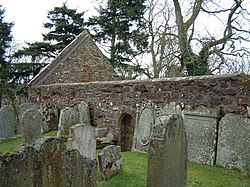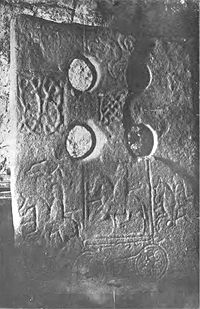Fordoun: Difference between revisions
Created page with "{{Infobox town |county=Kincardineshire |picture=St Palladius Fordoun.jpg |picture caption=St Palladius Fordoun |latitude = 56.872920 |longitude = -2.411751 |population= |LG d..." |
mNo edit summary |
||
| Line 7: | Line 7: | ||
|population= | |population= | ||
|LG district = Aberdeenshire | |LG district = Aberdeenshire | ||
|post town = | |post town = Laurencekirk | ||
|postcode = AB30 | |postcode = AB30 | ||
|dialling code = 01561 | |dialling code = 01561 | ||
|os grid ref = NO750758 | |os grid ref = NO750758 | ||
}} | }} | ||
'''Fordoun''' (pronounced "For-Dun") is a parish and village in [[Kincardineshire]]. '''Fothirdun''' (possibly "the lower place"), as it was historically known, was an important area in the Howe | '''Fordoun''' (pronounced "For-Dun") is a parish and village in [[Kincardineshire]]. '''Fothirdun''' (possibly "the lower place"), as it was historically known, was an important area in the [[Howe o' the Mearns]]. Fordoun and [[Auchenblae]], together with their immediate districts form the parish of Fordoun with the Parish Church<ref>{{cite web| url=http://www.mearns.org.uk/stonehaven/fordoun.htm| title=Fordoun and Auchenblae| accessdate=2007-04-29}}</ref> in the vicinity of the original settlement, now absorbed by Auchenblae. | ||
In the 19th Century a railway station was opened approximately three miles to the south-east of Fordoun Church and the original settlement. A village grew at the site of the railway named Fordoun Station (opened in November 1849 and closed in June 1956)<ref>{{cite web| url=http://www.railscot.co.uk/Aberdeen_Railway/frame.htm| title=Aberdeen Railway| accessdate=2007-04-29}}</ref> where there were also a number of shops, but only a pub and a seasonal farm shop remain.<ref name=mearns>{{cite web| url=http://www.mearns.org/blae.htm| title=Fordoun and Auchenblae| author=Mearn Community website| accessdate=2007-04-29}}</ref> In the time since the founding of the railway station the village formerly known as Fordoun Station has come to be known simply as Fordoun and the site of original settlement has been absorbed by Auchenblae. | In the 19th Century a railway station was opened approximately three miles to the south-east of Fordoun Church and the original settlement. A village grew at the site of the railway named Fordoun Station (opened in November 1849 and closed in June 1956)<ref>{{cite web| url=http://www.railscot.co.uk/Aberdeen_Railway/frame.htm| title=Aberdeen Railway| accessdate=2007-04-29}}</ref> where there were also a number of shops, but only a pub and a seasonal farm shop remain.<ref name=mearns>{{cite web| url=http://www.mearns.org/blae.htm| title=Fordoun and Auchenblae| author=Mearn Community website| accessdate=2007-04-29}}</ref> In the time since the founding of the railway station the village formerly known as Fordoun Station has come to be known simply as Fordoun and the site of original settlement has been absorbed by Auchenblae. | ||
Latest revision as of 08:51, 9 October 2015
| Fordoun | |
| Kincardineshire | |
|---|---|
 St Palladius Fordoun | |
| Location | |
| Grid reference: | NO750758 |
| Location: | 56°52’23"N, 2°24’42"W |
| Data | |
| Post town: | Laurencekirk |
| Postcode: | AB30 |
| Dialling code: | 01561 |
| Local Government | |
| Council: | Aberdeenshire |
Fordoun (pronounced "For-Dun") is a parish and village in Kincardineshire. Fothirdun (possibly "the lower place"), as it was historically known, was an important area in the Howe o' the Mearns. Fordoun and Auchenblae, together with their immediate districts form the parish of Fordoun with the Parish Church[1] in the vicinity of the original settlement, now absorbed by Auchenblae.
In the 19th Century a railway station was opened approximately three miles to the south-east of Fordoun Church and the original settlement. A village grew at the site of the railway named Fordoun Station (opened in November 1849 and closed in June 1956)[2] where there were also a number of shops, but only a pub and a seasonal farm shop remain.[3] In the time since the founding of the railway station the village formerly known as Fordoun Station has come to be known simply as Fordoun and the site of original settlement has been absorbed by Auchenblae.
- John of Fordun (d. c. 1384), Scottish Chronicler was born in the Parish of Fordoun.
- James Burnett, Lord Monboddo (1714–99), judge on the Court of Session lived at Monboddo House, a 17th-century house in the parish. He was author of The Origin and Progress of Man and Language, a study of evolution that predated the work of Charles Darwin.
- James Beattie (1735–1803), scholar and writer was born in Laurencekirk and first worked as schoolmaster in Fordoun. He became Professor of Moral Philosophy and Logic at Marischal College and is noted for his Essay on the Nature and Immutability of Truth (1770) and poem The Minstrel.[4]
History

There is a Pictish symbol stone, the Fordoun Stone (also known as St Palladius' Stone), in the parish church on the outskirts of Auchenblae at NO726784[5]
In his 1819 Geography, James Playfair notes that[6]
Fordoun is a mean town, and the seat of a presbytery, noted for being the birthplace or temporary residence of John Fordoun, author of the Scotichronicon; and of Palladius, who was sent by Pope Celestine into Scotland, in the 5th century, to oppose the Pelagian heresy. The chapel of Palladius, adjacent to the church, is 40 by 18 feet; at the corner of the minister's garden there is a well still called Paldy's well; and an Annual fair in the neighbourhood is styled Paldy-fair.
North of the village is a disused airfield that was active during World War II. A two-runway satellite for Peterhead airfield, Fordoun Aerodrome operated from 1942 to 1944.[7]
Notes
- ↑ "Fordoun and Auchenblae". http://www.mearns.org.uk/stonehaven/fordoun.htm. Retrieved 2007-04-29.
- ↑ "Aberdeen Railway". http://www.railscot.co.uk/Aberdeen_Railway/frame.htm. Retrieved 2007-04-29.
- ↑ Mearn Community website. "Fordoun and Auchenblae". http://www.mearns.org/blae.htm. Retrieved 2007-04-29.
- ↑ Julie Watt. "James Beattie Biography". http://www.brycchancarey.com/abolition/beattie.htm. Retrieved 2007-04-239.
- ↑ "Fourdoun Stone". http://www.aberdeenshire.gov.uk/archaeology/sites/pictish/fordoun.asp. Retrieved 2007-04-29.
- ↑ Playfair, James (1819). A Geographical and Statistical Description of Scotland. II. Edinburgh: Archibald Constable and Co.. p. 37. http://books.google.com/?id=Fw0vAAAAMAAJ. Retrieved 2008-08-03
- ↑ "Disused WWII Airfields in N.E. Scotland". Archived from the original on 2005-02-11. http://web.archive.org/web/20050211103007/http://www.geocities.com/Pentagon/Barracks/6344/fordoun.htm. Retrieved 2007-04-29.
| ("Wikimedia Commons" has material about Fordoun) |
